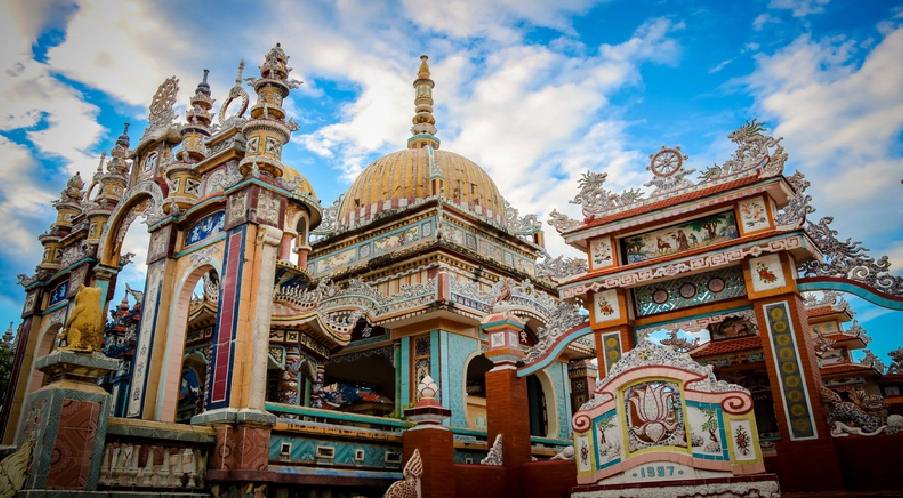Hue royal tombs, the moss-covered towers evoking the Nguyen Emperor history
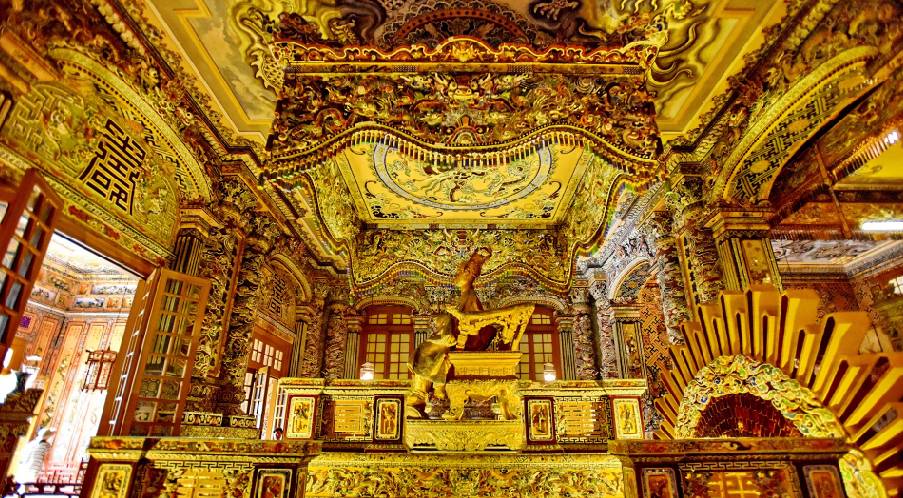
As the only city in Vietnam that still retains the appearance of a medieval city and intact architecture of a monarchy, Hue has become a great priceless museum. In particular, the most unique and unmissable places should be the system of ancient royal tombs of the Nguyen Kings. These works bring pinnacle architecture of traditional art in harmony with nature. If Gia Long Tomb is grandeur and serenity in the middle of a vast natural forest, then Minh Mang Tomb exudes a dignified look, in contrast to the peaceful and poetic Tu Duc Tomb; different from all is Khai Dinh tomb palace with the interference between Eastern and Western designs.
Read more: Hue – The ancient imperial city with dreamlike vibes
I. About Hue Royal Tombs
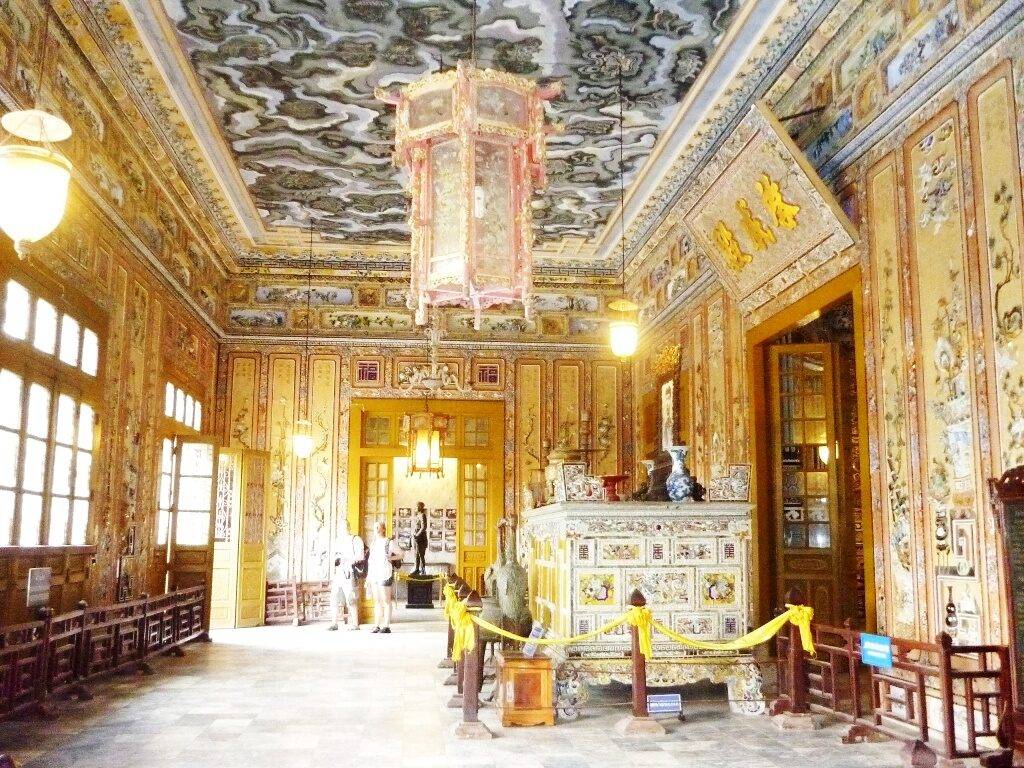
The Nguyen Dynasty (1802-1945), the last monarchy in the history of Vietnam, left the nation with a huge cultural heritage about the system of royal tombs in Hue city. The Nguyen Dynasty had 13 Kings, but for different historical reasons, only 7 mausoleums were built and remained – which are tombs of Gia Long, Minh Mang, Thieu Tri, Tu Duc, Duc Duc, Dong Khanh, and Khai Dinh.
The Kings were supposed to build their own tombs while they were still alive as the Confucian concept. The prefabricated tombs have two functions: as a resort for kings while alive, and a place to bury them when they died.
All these places were built and planned in accordance with Eastern Feng Shui philosophy, as well as following the theme of art and architecture chosen by the Kings. There were two main parts: the emperor’s tombs and a palace. The tomb area is used to bury the king’s body, and the other is where temples, shrines, communal houses, etc., are situated. Any tomb must comply with the rules related to natural geographical entities of rivers, mountains, lakes, streams, and especially, the “Mystic Palace” must be built at the good layer of earth.
Read more: THE FOREIGN NEWSPAPER RECOMMENDS 10 BEST BUN BO HUE SHOPS
II. Top 5 must-visit Hue royal tombs
1. Gia Long tomb
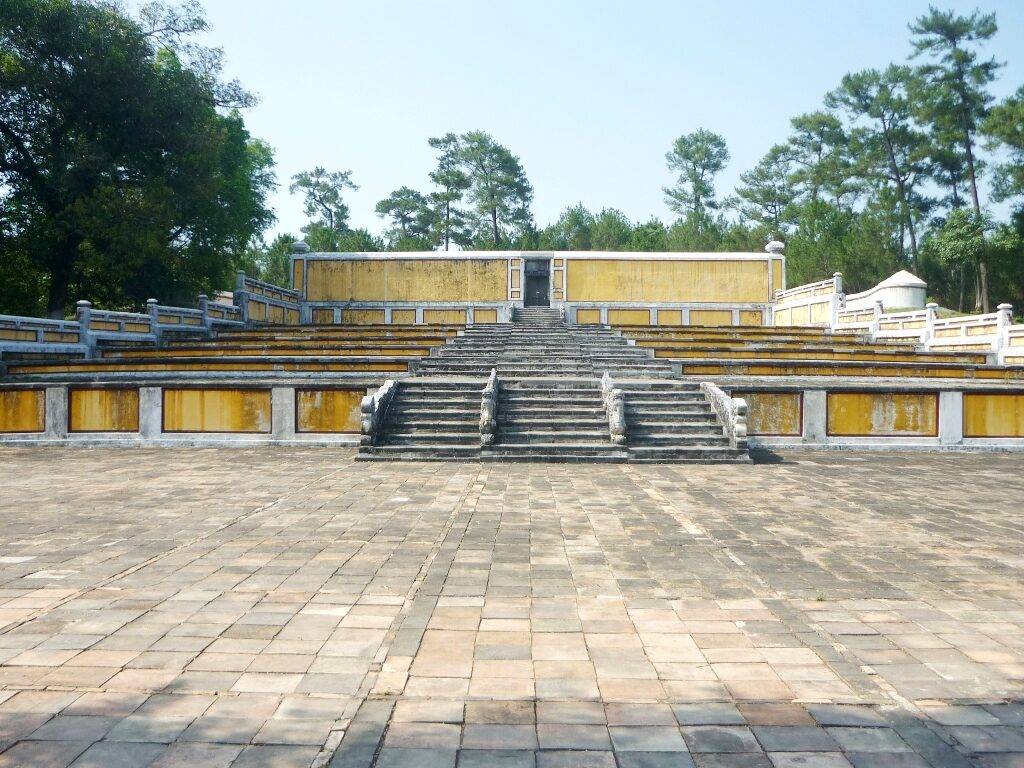
Located along the banks of the Perfume River with an area of 12,000m2, Gia Long Tomb, or Thien Tho Lang, is the tomb of Emperor Gia Long (1762-1820) who founded the Nguyen Dynasty. Surrounding the area are the majestic mountains; in which, the towering Dai Thien Tho mountain is in the front, while 28 other large and small ones are scattered around. From the banks of the Perfume River to the tomb is a wide road with tall, green pine and durian trees on both sides, creating a cool shade. The place is said to have the most beautiful feng shui location of all the Nguyen Dynasty tombs.
The entire area is divided into 3 different parts: in the center is the tomb of the King and his wife – Queen Thua Thien Cao; on the right is Minh Thanh palace used to worship the emperors of the first generation, and on the left is a sizable stele engraved with King Minh Mang’s words about the merits of King Gia Long.
In addition to the road, visitors can also visit the place by boat from Kim Ngoc wharf. The best time to visit Gia Long tomb is at sunset; at this time, the combination of the lake and the surrounding scenery and pine forest will help visitors feel the beauty to the fullest. Due to its seclusion and the architectural value less inferior to other Hue royal tombs, the place has been not so popular to most tourists.
2. Minh Mang tomb
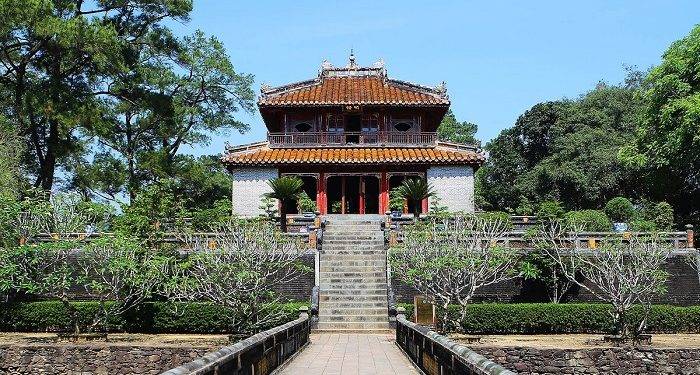
From the center of Hue citadel, traveling about 12km from Highway 49 and crossing Tuan bridge, you will reach Minh Mang Tomb. The tomb, with an area of 18 hectares, was built on Cam Khe mountain, which is the intersection of two Perfume River’s streams, Huu Trach and Ta Trach.
Although it was only built within 3 years, Minh Mang tomb is still known as one of the most elaborate mausoleums in Hue, including nearly 50 large and small detailed works designed in an extremely proportionate manner full of aesthetics. All are arranged in a vertical axis, starting with Dai Hong Mon, surrounded by 2 more doors – Ta Hong Mon and Huu Hong Mon; inside is a large yard with numerous stone statues; the ending part is the grave of King Minh Mang.
The tomb is open daily until 5 pm, therefore, try to arrange your time so that you don’t have to miss such a worth-seeing space.
3. Thieu Tri tomb
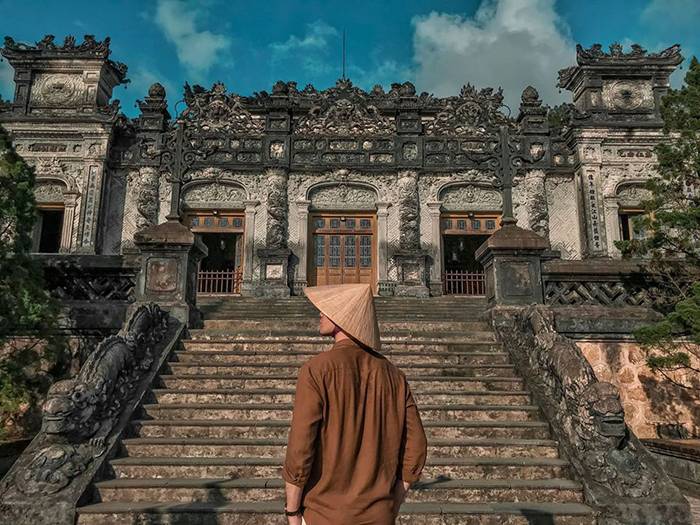
Thieu Tri tomb is located in Cu Chanh village, Huong Thuy Town, is the burial place of Emperor Thieu Tri (1807-1847), the third king of the Nguyen Dynasty. Compared to the two tombs of Gia Long and Minh Mang, this place is closer to the Citadel. It’s said to be a reconciliation of the two predecessors’ architectural models as being designed into two axes: the axis of the tomb on the right and the axis of the shrine area on the left. During his lifetime, King Thieu Tri carefully studied the two previous Kings’ tombs to be able to build for himself the most perfect resting place.
If other Hue royal tombs often bring a feeling of majesty and solemnity, Thieu Tri’s is different. This place captivates visitors by its closeness, familiarity, and airy space. Close to Thuan Dao mountain, the whole area is immersed among fruit-laden orchards and immense rice fields.
To reach Thieu Tri tomb, you should depart from the city center then follow the direction of Hong Duc Pagoda about 8km. The entrance ticket is about 40,000 VND/person and the place is also only open until 5 p.m.
4. Tu Duc tomb
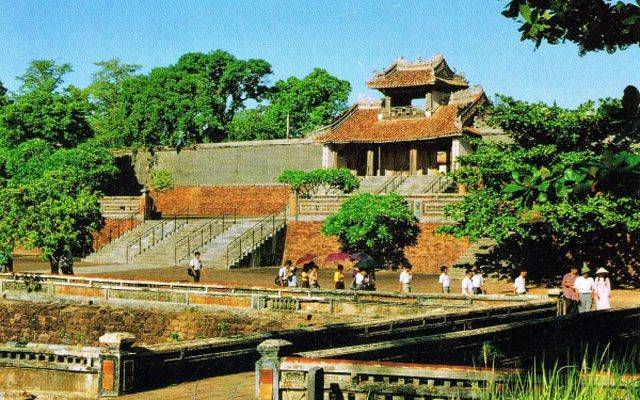
Tu Duc tomb, or Khiem Lang in Thuy Xuan ward, is the resting place of King Tu Duc (1829 – 1883) – the King with the longest reign of the Nguyen dynasty. When alive, right after choosing a suitable location, King Tu Duc started the construction immediately and named it Van Nien Co. Later on, since the project has caused so many deaths, Tu Duc changed Van Nien Co to Khiem Cung (Khiem means modest).
The tomb is located in the highest spot in the area, surrounded by ancient pine forests and porcelain trees. The layout consists of two main parts on two parallel axes; in front is Giang Khiem mountain, behind is Duong Xuan mountain and on the campus is Luu Khiem lake. The whole mausoleum includes more than 50 large and small works impressed by the winding streets paved with Bat Trang bricks, monuments, and sophisticatedly carved patterns.
The space appears fresh, poetic with trees, rivers, and a huge lotus lake, just to harmonize the solemnity of the tomb.
5. Khai Dinh tomb
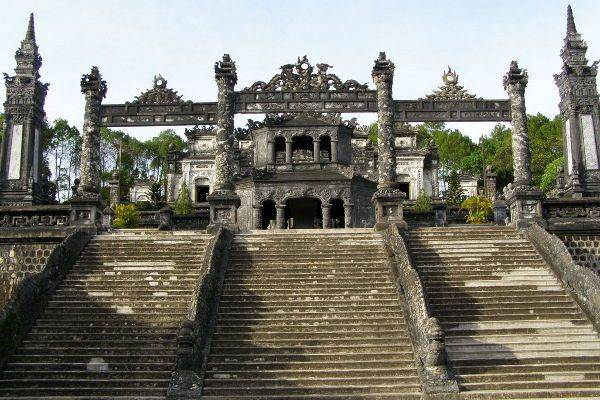
Khai Dinh tomb, located at Chau Chu Mountain, Huong Thuy District, is the 12th Nguyen Dynasty (1885-1925) King tomb with the construction period lasting up to 11 years.
Although not grandiose in size, the tomb impresses with its sophisticated and sharp design. There, we will realize the harmonious interference between Eastern classical beauty and Western modernity. The tomb is built in the form of a rectangular block, with 127 steps leading to the main mausoleum. At the gate are two tower-shaped pillars in Indian architectural colors, while the surrounding pillars are typical of Eastern Buddhism. The outer barrier bars are crucifix-shapes, and the arched arches are characteristic of Roman art. All these features have helped Khai Dinh Tomb become the most unique symbol among Hue royal tombs.
Notably, Thien Dinh palace, located in the center of the mausoleum, also contains valuable furniture, most notably the monumental painting “Nine dragons hide in the clouds” which still retains its value to this day. Khai Dinh tomb is open from 7:00 a.m to 5:30 p.m every day.
III. Notes when visiting Hue royal tombs
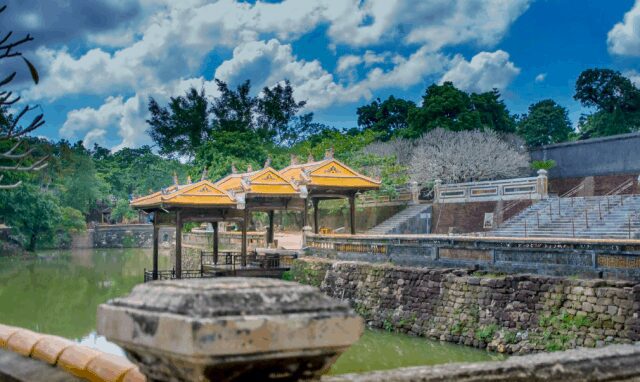
– Entrance tickets to each tomb will vary from 40,000 VND/adult and about 30,000 VND/child over 7 years old. It will take visitors about 30 – 1 hour to wander around each place.
– The best means to move between the tombs is by motorbike or taxi. Motorbike rental fee in Hue city ranges from
120,000- 200,000 VND/day. The parking fee is from 5,000 to 10,000 VND/motorbikes.
– The best time to visit Hue royal tombs is from January to July, when the weather is pleasant, sometimes sunny, without rains and storms.
– Bring along glasses, hats, umbrellas, as well as sun cream and water to protect you from sunburn and dehydration.
– Try to put on polite clothes when entering these sacred places.
– Most of the places are free to take pictures, however, some are not allowed, so make sure to check the sign first.
Read more: MUST-TRY DESSERTS IN HUE
